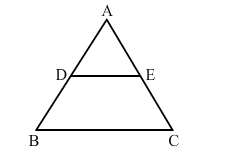$D$ and $E$ are points on the sides $A B$ and $A C$ respectively of a $\triangle A B C$. In each of the following cases, determine whether $D E \| B C$ or not.

(i) $A D=5.7 \mathrm{~cm}, D B=9.5 \mathrm{~cm}, B D=4.8 \mathrm{~cm}$ and $E C=8 \mathrm{~cm}$.
(ii) $A B=11.7 \mathrm{~cm}, A C=11.2 \mathrm{~cm}, B D=6.5 \mathrm{~cm}$ and $A E=4.2 \mathrm{~cm}$.
(iii) $A B=10.8 \mathrm{~cm}, A D=6.3 \mathrm{~cm}, A C=9.6 \mathrm{~cm}$ and $E C=4 \mathrm{~cm}$.
(iv) $A D=7.2 \mathrm{~cm}, A E=6.4 \mathrm{~cm}, A B=12 \mathrm{~cm}$ and $A C=10 \mathrm{~cm}$.
(i) We have:
$\frac{\mathrm{AD}}{\mathrm{DB}}=\frac{5.7}{9.5}=0.6 \mathrm{~cm}$
$\frac{\mathrm{AE}}{\mathrm{EC}}=\frac{4.8}{8}=0.6 \mathrm{~cm}$
Hence, $\frac{\mathrm{AD}}{\mathrm{DB}}=\frac{\mathrm{AE}}{\mathrm{EC}}$
Applying the converse of Thales' theorem,
we conclude that $\mathrm{DE} \| \mathrm{BC}$.
(ii)
We have:
AB = 11.7 cm, DB = 6.5 cm
Therefore,
AD = 11.7
Similarly,
AC = 11.2 cm, AE = 4.2 cm
Therefore,
EC = 11.2
Now,
$\frac{\mathrm{AD}}{\mathrm{DB}}=\frac{5.2}{6.5}=\frac{4}{5}$
$\frac{\mathrm{AE}}{\mathrm{EC}}=\frac{4.2}{7}$
Thus, $\frac{\mathrm{AD}}{\mathrm{DB}} \neq \frac{\mathrm{AE}}{\mathrm{EC}}$
Applying the converse of Thales' theorem,
we conclude that DE is not parallel to BC.
(iii)
We have:
AB = 10.8 cm, AD = 6.3 cm
Therefore,
DB = 10.8
Similarly,
AC = 9.6 cm, EC = 4 cm
Therefore,
AE = 9.6
Now,
$\frac{\mathrm{AD}}{\mathrm{DB}}=\frac{6.3}{4.5}=\frac{7}{5}$
$\frac{\mathrm{AE}}{\mathrm{EC}}=\frac{5.6}{4}=\frac{7}{5}$
$\Rightarrow \frac{\mathrm{AD}}{\mathrm{DB}}=\frac{\mathrm{AE}}{\mathrm{EC}}$
Applying the converse of Thales' theorem,
we conclude that $\mathrm{DE} \| \mathrm{BC}$.
(iv)
We have:
AD = 7.2 cm, AB = 12 cm
Therefore,
DB = 12
Similarly,
AE = 6.4 cm, AC = 10 cm
Therefore,
EC = 10
Now,
$\frac{\mathrm{AD}}{\mathrm{DB}}=\frac{7.2}{4.8}=\frac{3}{2}$
$\frac{\mathrm{AE}}{\mathrm{EC}}=\frac{6.4}{3.6}=\frac{16}{9}$
Thus, $\frac{\mathrm{AD}}{\mathrm{DB}} \neq \frac{\mathrm{AE}}{\mathrm{EC}}$
Applying the converse of Thales' theorem, we conclude that $\mathrm{DE}$ is not parallel to $\mathrm{BC}$.
